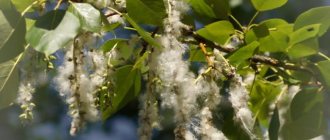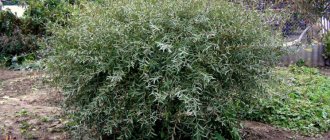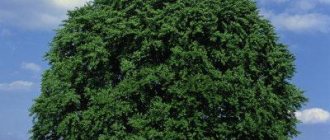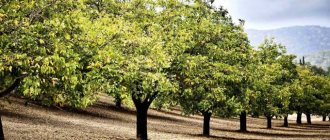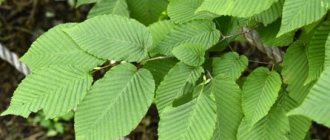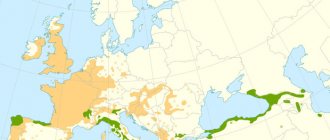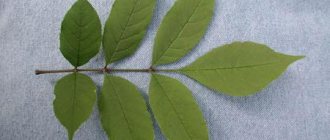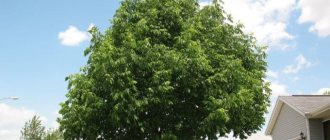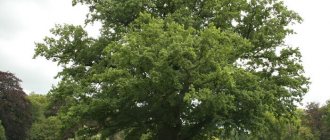Hornbeam is a small deciduous tree, a member of the Birch family. The way a hornbeam tree looks depends on its species, of which there are more than 40. Hornbeam is often used in landscape design - for landscaping garden plots and park areas. Its wood is famous for its strength and strength, therefore it has long been used for industrial needs. The various shapes of the crown and its color, the different colors of foliage from emerald to crimson-red shades have made the hornbeam popular among gardeners and landscape designers.
Features of hornbeam trees
Catkins appear in the spring, with male and female flowers on separate catkins located on the same tree. They are wind pollinated, and the pollinated catkins develop into “winged” fruits, from which a young Hornbeam tree can be planted and grown.
Hornbeam sheds its leaves in winter, but they remain on the branches long after they have acquired their "autumn" color and, in warm regions, remain until fresh growth emerges in the spring.
Their characteristics are similar to beech trees, although hornbeam is actually a member of the birch family. This trait, combined with the dense foliage, makes hornbeam trees particularly suitable for hedges, providing privacy and protection from noise and wind.
How does a plant reproduce?
Hornbeam can “reproduce” in three ways - natural biologically using seeds, cuttings or layering.
Cuttings
For this method, cut tree branches approximately fifteen centimeters long are best suited. It is best to cut them at the end of September - beginning of October, and after that, immediately wrap them in a damp cloth and put them in a cool place, for example, a refrigerator. In the spring, the cuttings are taken out of the cold, soaked for some time in potassium permanganate, and then immersed in cold tap water for three days. As soon as five or six leaves appear on the cutting, it can be planted in nutritious soil - this will ensure that the tree will take root in most cases.
Propagation by seeds
This method gives the most productive result, but it is also the most difficult. In mid-late September, nuts are collected and kept in a cellar or refrigerator in various containers - canvas bags, cardboard boxes. In about one and a half to two months, the seeds are removed from the refrigerator and kept in a room with a temperature of about 25 degrees. Then, after one and a half to two months, the hornbeam seeds (nuts) are soaked in warm water and placed in containers with specially “fed” soil.
Reproduction by layering
This method is used least often and only with shrubby types of hornbeams; this method gives the smallest chance of germination compared to the others. To do this, a trench is dug in the ground next to the bush, into which you need to place a branch bent down, previously cut. The branch is fixed with earth from above and watered with water and nutrient solutions. After about a month, if the outcome is favorable, the first shoots emerge from the ground - this is a signal that the layering can be removed from the main tree.
Planting and growing Hornbeam
Hornbeam trees are ideal for planting in a wide range of conditions. They are especially hardy and tolerant of external influences. Also a good alternative to beech in slightly damp conditions. When purchasing a seedling, there will be no difficulties in growing and caring for it.
If a clean and smooth trunk is desired when planting, you can trim the lower branches of young hornbeams.
With this, the trees create a well-balanced growth of branches, and established hornbeam trees only require cleaning by removing cracked or damaged branches.
Reproduction
The plant reproduces in two ways. The most common method is to graft a cutting into a triangular cut on a prepared plant. It is carried out in the spring, the joint areas are coated with garden varnish and tied.
It is also possible to plant cuttings. It includes a number of points.
- Leafy shoots 10-15 cm long are harvested. The optimal time is late spring or early summer.
- The base of future seedlings is placed in a solution that stimulates root formation for 1-2 hours.
- The harvested cuttings are transferred to the greenhouse. They are placed in a moist substrate of leaf humus and sand.
The appearance of roots takes 10 days. The next season until autumn, the plants are kept in the substrate, then transplanted to a permanent place. For the winter, young shoots will need reliable shelter.
General characteristics
- Family: Birch
- Botanical name: Betulaceae
- Planting location: residential areas, gardens, parks, landscaping of city parks.
- Foliage: Deciduous (loses leaves seasonally)
- Hornbeam size range: medium tree (7-10 meters), small tree (4-7 meters)
- Light Exposure: Full sun (6 hours of direct light daily), partial sun/shade (4-6 hours of light daily), full shade (4 hours or less of light daily)
- Soil Preference: Acidic and moist, well-drained soil
- Allowed: dry and wet areas, alkaline and clay soil.
- Soil salt: zero tolerance
- Drought conditions: moderately tolerable
- Growth rate: slow
Other notable characteristics of hornbeam include:
Bark: Young trees have smooth gray bark with light grooves. Mature trees have dark gray bark with deep grooves and ridges.
Leaves: Measuring about 7-10 centimeters in length, hornbeam leaves are elliptical in shape and densely veined with pointed tips. They resemble a wedge with jagged edges. The upper part of the leaves is dark green and the lower part is pale green. In autumn the leaves turn bright red, scarlet and orange. In winter, brown leaves sometimes hang from the tree.
Flowers: Hornbeam has male and female blooms. The first are yellowish earrings about five centimeters long, and the second are green earrings that grow up to two centimeters.
Fruit: The small hornbeam nut is contained in catkins that are attached to leaves with three lobes.
Kinds
Hornbeam is a common plant, and there are a large number of its varieties:
- European, or common, which is found throughout mainland Europe. A tall plant with a natural ovoid crown shape.
- Cordifolia, or seaside - its feature can be called transparent leaves, ideal for gardens and parks. Such a hornbeam is able to provide a sufficient amount of shade without depriving shrubs and other plants in the lower part of sunlight.
- Carolina, or North American - this plant does not like shade and low temperatures and requires a large amount of moisture. Therefore, it grows exclusively on the banks of reservoirs. And it does not reach large sizes.
- Virginsky, which is preferred by designers and decorators for its unusual crown.
- Caucasian hornbeam, which has a unique curved trunk and the ability to protect the soil from washing out and subsidence processes. Usually grows on mountain slopes.
- Black, or decorative hornbeam, native to Asia (Japan), suitable for decorating exotic bonsai.
Variety Turchaninova
A low species, more often found in China, in mountainous areas. The species is decorative and beautiful, but is rare, which is why it is valued among lovers of this plant. Foliage color changes constantly throughout its life cycle.
READ Acacia tree or bush?
Tree care
Growing conditions for Hornbeam are not the most difficult; most often these are unpretentious plants. Choosing a place to plant a tree will not be particularly difficult. They grow in sun or shade and prefer soil rich in organic matter.
Young hornbeams need regular watering when there is no rain, but as they age they will tolerate longer periods between waterings.
Organic soil that holds moisture well can help reduce the amount of additional watering.
Hornbeam growing in good soil does not need to be fertilized unless the foliage is pale or the tree is not growing well.
Pruning the hornbeam depends on the needs, that is, on the place where it grows; for example, a smaller tree is suitable for a small garden, but for a city park or green hedge behind the house you can allow the Hornbeam to grow without cutting off the branches.
The tree requires very little pruning for good health. The branches are strong and rarely require gartering or additional care.
However, some experts believe that after the summer growth spurt, deciduous hedges such as beech and hornbeam should be pruned before the leaves change color and fall off. September is the best month for this. Deciduous hedges are best trimmed with pruning shears rather than hedge trimmers or scissors.
Video: Homemade big wooden mallet
It has very hard, abrasion-resistant wood. As it grows, the hornbeam trunk becomes bent and becomes unsuitable for construction, but nevertheless, its wood has been highly valued since ancient times. It was used in foundry, blacksmithing and jewelry making. The wood of this tree produces a smokeless flame, which allowed it to be used in bakeries and pottery workshops. Its strong and durable wood was and is still used to this day for making handles for various tools, axes, and various combs. Currently, it is used to produce billiard cues, cutting boards, flooring, parquet, all kinds of machines and other everyday items.
Despite the fact that hornbeam is strong and durable, without additional external protection it quickly loses its characteristics. At the same time, it is very easy to paint and treat with other protective chemicals.
The leaves and especially the young shoots of this tree can be fed to livestock. The bark is used for tanning hides, and essential oils are extracted from the leaves, which are used in modern cosmetology. Hornbeam fruit produces oil that can be used in cooking.
This tree has not been ignored by medicine. Hornbeam bark and leaves contain a large proportion of tannins, aldehydes, gallic and caffeic acids, bioflavonoids, coumarins, essential oils and ascorbic acid. The fruit contains vegetable fats. For improper blood circulation and brain neoplasia, infusions from the flowers of this tree are used. Young shoots are an integral part of the medicinal collection used for infertility and complications during pregnancy. In the same way, an infusion of leaves is used for diarrhea. The sap of this tree contains a lot of sugar and organic substances.
History and use of hornbeam trees
Carpinus betulus is native to Great Britain as well as other parts of Europe and Asia. In the UK it is mainly found in ancient woodlands around Hertfordshire, Essex and Kent, and in ornamental gardens.
The name "Hornbeam" comes from the Latin "horn" for the hardiness of the wood, and "beam" in Old English for wood. Carpinus is the ancient Latin name for the species.
Hornbeam trees have a rich folklore history. The leaves were made into a tonic to treat fatigue and exhaustion, and the leaves were commonly used to prevent bleeding and heal wounds.
Hornbeam produces a very hard wood known as ironwood. Because it is difficult to work with, it is not usually used in carpentry, however, when particularly hard wood is required, it comes in handy.
Examples of hornbeam uses include: pianos, carving boards, tool handles, parquet floors, chess pieces, and gears in early machinery.
An excellent shade tree suitable for most conditions. Hornbeams are compact trees that fit perfectly into the scale of a typical garden or urban landscape.
Where does it grow?
Most hornbeam varieties grow in Asian countries, mainly in China. In Europe, only two types of culture are represented, but almost everywhere. In Russia, the tree can only be found in the Caucasus. Interestingly, hornbeam also grows in Iran.
Photo of hornbeam tree
Expert advice
When using this variety from which a hedge is formed, it is important to consider what it can be combined with. In the wild, the plant gets along well next to beech and oak. When developing a landscape project, gardeners place jasmine bushes, juniper, and conifers next to it. Such compositions look simply great throughout the year. The planting scheme is developed individually, taking into account the wishes of the owner of the site and other features of the garden.
Science has proven the healing properties of this type of tree. It is recommended to plant for people who suffer from chronic fatigue. Plants allow you to form correct, objective views on life and existing reality. Wood allows you to gain strength.
The formation of the plant is directly related to other structural elements in the garden. The holistic composition of the entire garden makes it possible to create a cozy atmosphere for family living and relaxation.

